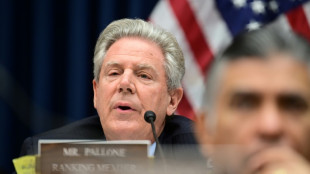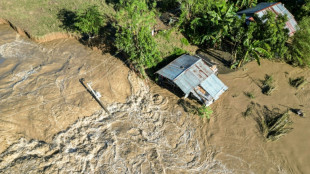
-
 NATO holds large Arctic exercises in Russia's backyard
NATO holds large Arctic exercises in Russia's backyard
-
Trouble brews in India's Manipur state

-
 Son of Norwegian princess arrested on suspicion of rape
Son of Norwegian princess arrested on suspicion of rape
-
Romanian court says 'irregularities' in influencer Andrew Tate's indictment

-
 Iran faces fresh censure over lack of cooperation at UN nuclear meeting
Iran faces fresh censure over lack of cooperation at UN nuclear meeting
-
Despondency and defiance as 45 Hong Kong campaigners jailed

-
 Scholar, lawmakers and journalist among Hong Kongers jailed
Scholar, lawmakers and journalist among Hong Kongers jailed
-
European stocks slide on fears of Russia-Ukraine escalation

-
 Police break up Georgia vote protest as president mounts court challenge
Police break up Georgia vote protest as president mounts court challenge
-
Spain royals visit flood epicentre after chaotic trip

-
 France's Gisele Pelicot says 'macho' society must change attitude on rape
France's Gisele Pelicot says 'macho' society must change attitude on rape
-
G20 leaders talk climate, wars -- and brace for Trump's return

-
 US lawmaker accuses Azerbaijan in near 'assault' at COP29
US lawmaker accuses Azerbaijan in near 'assault' at COP29
-
Tuchel's England have 'tools' to win World Cup, says Carsley

-
 Federer hails 'historic' Nadal ahead of imminent retirement
Federer hails 'historic' Nadal ahead of imminent retirement
-
Ukraine vows no surrender, Kremlin issues nuke threat on 1,000th day of war

-
 Novo Nordisk's obesity drug Wegovy goes on sale in China
Novo Nordisk's obesity drug Wegovy goes on sale in China
-
Spain royals to visit flood epicentre after chaotic trip: media

-
 French farmers step up protests against EU-Mercosur deal
French farmers step up protests against EU-Mercosur deal
-
Rose says Europe Ryder Cup stars play 'for the badge' not money

-
 Negotiators seek to break COP29 impasse after G20 'marching orders'
Negotiators seek to break COP29 impasse after G20 'marching orders'
-
Burst dike leaves Filipino farmers under water

-
 Markets rally after US bounce as Nvidia comes into focus
Markets rally after US bounce as Nvidia comes into focus
-
Crisis-hit Thyssenkrupp books another hefty annual loss

-
 US envoy in Lebanon for talks on halting Israel-Hezbollah war
US envoy in Lebanon for talks on halting Israel-Hezbollah war
-
India to send 5,000 extra troops to quell Manipur unrest

-
 Sex, drugs and gritty reality on Prague's underworld tours
Sex, drugs and gritty reality on Prague's underworld tours
-
Farmers descend on London to overturn inheritance tax change

-
 Clippers upset Warriors, Lillard saves Bucks
Clippers upset Warriors, Lillard saves Bucks
-
Acquitted 'Hong Kong 47' defendant sees freedom as responsibility

-
 Floods strike thousands of houses in northern Philippines
Floods strike thousands of houses in northern Philippines
-
Illegal farm fires fuel Indian capital's smog misery

-
 SpaceX set for Starship's next flight, Trump expected to attend
SpaceX set for Starship's next flight, Trump expected to attend
-
Texans cruise as Cowboys crisis deepens

-
 Do the Donald! Trump dance takes US sport by storm
Do the Donald! Trump dance takes US sport by storm
-
Home hero Cameron Smith desperate for first win of 2024 at Australian PGA

-
 Team Trump assails Biden decision on missiles for Ukraine
Team Trump assails Biden decision on missiles for Ukraine
-
Hong Kong court jails 45 democracy campaigners on subversion charges

-
 Several children injured in car crash at central China school
Several children injured in car crash at central China school
-
Urban mosquito sparks malaria surge in East Africa

-
 Djibouti experiments with GM mosquito against malaria
Djibouti experiments with GM mosquito against malaria
-
Pulisic at the double as USA cruise past Jamaica

-
 Many children injured after car crashes at central China school: state media
Many children injured after car crashes at central China school: state media
-
Asian markets rally after US bounce as Nvidia comes into focus

-
 Tens of thousands march in New Zealand Maori rights protest
Tens of thousands march in New Zealand Maori rights protest
-
Five takeaways from the G20 summit in Rio

-
 China, Russia ministers discuss Korea tensions at G20: state media
China, Russia ministers discuss Korea tensions at G20: state media
-
Kohli form, opening woes dog India ahead of Australia Test series

-
 Parts of Great Barrier Reef suffer highest coral mortality on record
Parts of Great Barrier Reef suffer highest coral mortality on record
-
Defiant Lebanese harvest olives in the shadow of war


Why did North Korea fake a 'monster missile' test?
North Korea faked a "successful" launch of its most powerful long-range missile to shore up domestic support for Kim Jong Un's regime after the real test ended in failure, analysts say.
State media trumpeted the "miraculous" launch of what it claimed was a new Hwasong-17 intercontinental ballistic missile on March 24, publishing dramatic photos and videos of leader Kim personally overseeing the test.
But analysts identified discrepancies in Pyongyang's account, and South Korean and US intelligence agencies have concluded that North Korea actually fired a Hwasong-15 -- a less-advanced ICBM which it had already tested in 2017.
Why would North Korea do this? Analysts say it urgently needed a domestic propaganda victory ahead of a key anniversary, after the real launch of the Hwasong-17 a week before ended in failure with the missile exploding above the capital Pyongyang.
"North Korea wanted to shore up citizens' loyalty ahead of the Day of the Sun by branding Kim Jong Un a capable leader of a military powerhouse," analyst Yang Moo-jin told AFP, referring to the birth anniversary of founding leader Kim Il Sung on April 15.
But "the March 16 launch failed spectacularly and -- worse -- it happened in Pyongyang so people got to witness the dramatic failure. Kim probably thought he needed something very strong to make up for it, and that's probably why he lied," Yang added.
A South Korean intelligence briefing said that after the botched March 16 launch, Pyongyang turned to fabrication "to stem rumours and bring regime stability," local reports said.
With only eight days between the failed launch and the purported successful one, there would have been no time to analyse what went wrong and actually correct it -- hence why Pyongyang turned to subterfuge, the reports added.
- Fake it til you make it? -
It would not be the first time North Korea has fabricated weapons development progress -- it attempted to pass off a failed January 2016 submarine-launched ballistic missile test as a success using altered video footage, analysts said.
It is surprising that Pyongyang is still up to "such 'fake it till you make it' shenanigans", said Mason Richey, an associate professor at Hankuk University.
The fact that independent analysts -- let alone US and South Korean intelligence -- were able to detect it so quickly undermines North Korea's credibility, he said.
If Pyongyang has "lied about something as apparently obvious as ICBM type, have they also lied about more opaque areas", like whether their missiles survive re-entry or how light and compact their warheads are.
If the credibility of its nuclear deterrent is called into question, it "could make uber-hawkish defence officials in the US a bit itchier to try a bloody-nose or decapitation strike in future US-North Korea crises," he added.
North Korea announced the purported Hwasong-17 launch with a slick, Hollywood-style video featuring leader Kim in a black leather jacket and sunglasses, flanked by generals, appearing to give the signal to launch a giant missile.
But discrepancies spotted in that footage were what first tipped analysts off that the official version of events was misleading at best.
Seoul-based specialist website NK News analysed satellite imagery and found indications that some of the footage was filmed earlier than state media claimed, likely at the failed March 16 test.
"Kim Jong Un was likely targeting domestic audiences, to suppress rumours likely spreading over the highly visible ICBM failure over Pyongyang the previous week," and to boost "nationalistic pride" ahead of April 15, NK News analyst Colin Zwirko told AFP.
"He might not have wanted to waste the Hwasong-17 footage and wasn't able to launch another quickly, and telling the truth about a Hwasong-15 test would have lacked impact", as it was first tested in 2017, he added.
- Propaganda revolution -
The fact that Kim himself was front and centre of the event indicates that the propaganda was aimed at shoring up support for the leader personally, Hong Min of the Korea Institute for National Unification said.
"The North faked a Hwasong-17 launch out of a strong drive to show achievements under Kim's watch to the public with Kim at the centre," he said.
The dramatic KCTV video announcing Hwasong-17 was a "major departure" from previous North Korean propaganda efforts, said Rachel Minyoung Lee, a non-resident fellow with the 38 North programme at the Washington-based Stimson Center.
"It's a revolution in the history of North Korean propaganda," she told AFP.
While state propaganda has changed and evolved since Kim Jong Un came to power, largely to compete with the influx of foreign movies and dramas, this took things to a new level, she said.
"It had to up its game and make propaganda content more real, interesting, and persuasive," she said, even if the events it purportedly documented were a fabrication.
E.Flores--AT
